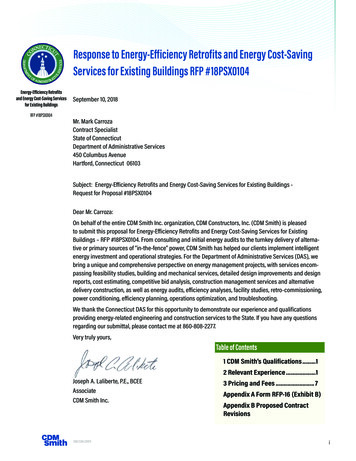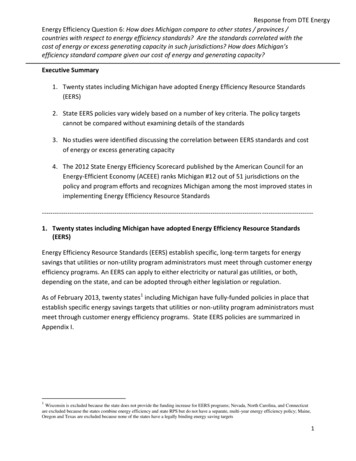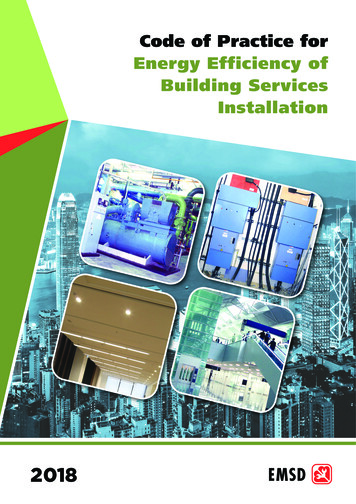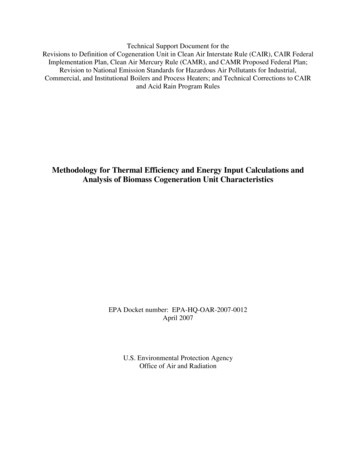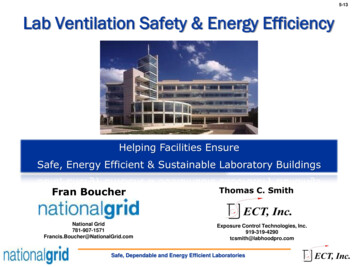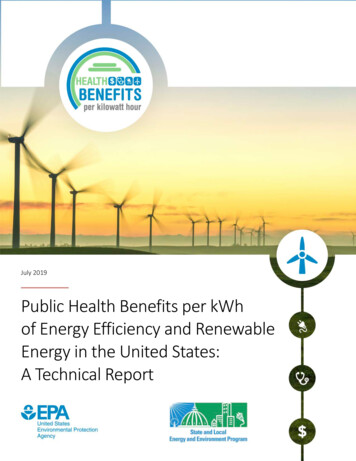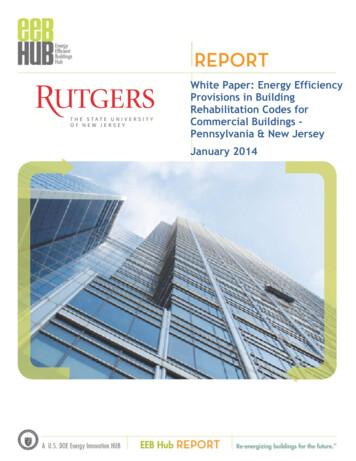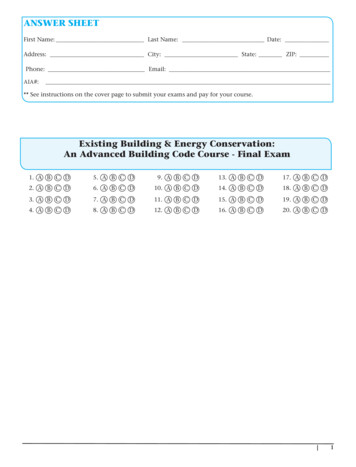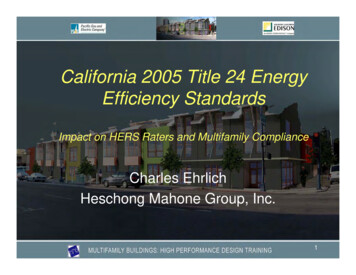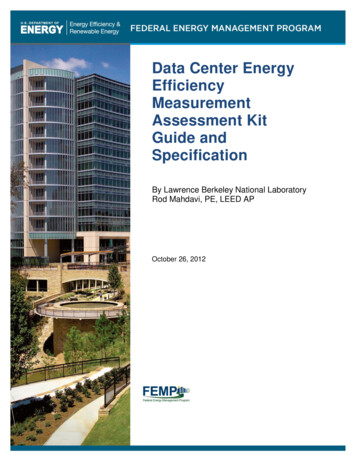
Transcription
Data Center EnergyEfficiencyMeasurementAssessment KitGuide andSpecificationBy Lawrence Berkeley National LaboratoryRod Mahdavi, PE, LEED APOctober 26, 2012
AcknowledgementsThis report was prepared for the Federal Energy Management Program by Rod Mahdavi ofLawrence Berkeley National Laboratory. The work was supported by the Federal EnergyManagement Program led by Will Lintner.ContactsAuthor:Rod Mahdavi, P.E. LEED APLawrence Berkeley National LaboratoryOne Cyclotron RoadM.S. 90-3411EBerkeley, CA 94720510.495.2259rmahdavi@lbl.govFor more information on FEMP:Will Lintner, P.E., CEMFederal Energy Management ProgramU.S. Department of Energy1000 Independence Ave., S.W.Washington, D.C. 20585-0121202.586.3120william.lintner@ee.doe.gov
Table of ContentsSummary .5Guide/Specification Scope .6Target Audience .6What This Guide Does .6What This Guide Does Not Do .6Data Center Monitoring .6Background .6Data Center Supporting Infrastructure Efficiency Metrics .7Wireless Network Specification .8Description .8Architecture Requirements .9Components And Features Specifications .9Scope of Work .12Assessment Kit .12Assessment Kit Installation and Commissioning .14Purpose.14Process .14System Data Presentation .15References .16
List of FiguresFigure 1: Wireless Mesh Network Architecture . 9Figure 2: Typical Monitoring Solutions . 13
Data Center Energy Efficiency Assessment Kit Guide and SpecificationSummaryA portable and temporary wireless mesh assessment kit can be used to speed up and reduce thecosts of a data center energy use assessment and overcome the issues with respect to shutdowns.The assessment kit is comprised of temperature, relative humidity, and pressure sensors. Alsoincluded are power meters that can be installed on computer room air conditioners (CRACs)without intrusive interruption of data center operations. The assessment kit produces datarequired for a detailed energy assessment of the data center. Its design incorporates the followingconsiderations: Measurement of environmental parameters (temperature, humidity, pressure) and powerthrough a non-intrusive, non-interruptive process. These parameters (temperature, dew point) at server intakes are recognized by ASHRAEfor standardization of server cooling performance. Air management improvement will provide grounds for increasing data center temperaturecloser to ASHRAE recommended or allowable numbers. Graphical reports (maps) for different parameters provide an accurate understanding of datacenter operationThis kind of study and report can cost much more and take much longer if conventional wiredtechnologies are used. For comparison, a sensing point for the wireless network can cost 100 150. A similar wired sensing point can cost 500 to 1,000.Federal Energy Management Program5
Data Center Energy Efficiency Assessment Kit Guide and SpecificationGuide and Specification ScopeTarget AudienceThis guide is primarily intended for personnel including Information Technology (IT) andfacilities managers who are responsible for managing data center energy use.What This Guide DoesThis guide introduces an assessment kit for data center assessment, and presents its advantagesand limitations. Additionally, the guide describes the assessment kit’s components, specifies therequirements of the assessment kit and its components, guides the user through the assessmentkit’s installation, and lists and describes the data required for computing the proposed metricsused to determine power usage effectiveness (PUE).What This Guide Does Not DoThis guide does not address IT efficiency and productivity metrics. While the energy efficiencymeasurement approach described in this guide can be used to identify potential efficiencyopportunities in HVAC and electrical systems, this guide does not constitute a detailed energyaudit procedure or checklist. However, the results may be used by a trained energy auditor aspart of an energy audit procedure, or to help prioritize areas for more in-depth audits. This guidedoes not describe the opportunities that result from the assessments or how to calculate savingsfrom the potential actions identified. The owners of data centers are encouraged to hire trainedenergy auditors with data center experience to conduct their audits. The Department of Energyhas established a data center energy practitioner program to train and certify such auditors.Data Center MonitoringBackgroundMonitoring data centers for energy efficiency is an important factor in their efficient operation.Environmental monitoring can provide a map of cooling system performance that can be used tohelp detect and address deficiencies. Other monitoring can segregate the power used by variouscomponents and systems, as well as reveal data center power distribution losses. Many sensingpoints are required to create a reasonable map of data center energy usage performance. This is agranular monitoring approach that monitors both environmental parameters such as temperature,dew point, pressure, and power in the data center at many locations and levels.Granular monitoring should help data center stakeholders accomplish the following: Identify baseline energy usage and improvement opportunities Measure real-time power usage and estimate PUE, which is calculated by dividing totalestimated annual energy used by estimated IT equipment annual energy use Interpret temperature, humidity, and sub-floor pressure differential data from hundreds ofsense points into intuitive live imaging maps6Federal Energy Management Program
Data Center Energy Efficiency Assessment Kit Guide and Specification Monitor environmental conditions to stay within specified recommended and/or allowableASHRAE ranges and provide alerts when boundaries are exceeded.This monitoring should consist of three basic components: the wireless network, a consoleapplication, and a browser-based user interface.The principal objective of this work is to use the assessment kit’s capability to improve therobustness of the assessment. This process helps to create an accurate understanding of datacenter operation, evaluate air management in the data center, and calculate PUE.Data Center Supporting Infrastructure Efficiency MetricsPrincipal ParametersAs described in Self-Benchmarking Guide for Data Center Infrastructure: Metrics, Benchmarks,Actions, issued in 2010, the principal parameters for measuring/affecting energy use include thefollowing (this list has been modified for this guide): Power Usage Effectiveness (PUE), percent of total used energy to IT used energy Air Supply Temperature at IT intake (degF) Relative Humidity Range at IT Intake (percent) Return Temperature Index (RTI) (percent) Data Center Cooling System Efficiency (kW/ton) Airflow Efficiency (watts per cubic feet per minute, W/cfm) Data Center Power Distribution System Efficiency (percent) Data Center Lighting Power Density (watts per square foot, W/sf)Wireless technology should enable measurements that are essential for the computation of theabove metrics.Air Cooling Efficiency MetricsAir cooling efficiency metrics indicate how effectively cooling resources are being employed.The monitoring system should calculate and display, at a minimum, the following metrics, whichhave been developed by industry consensus: Rack Cooling Index (RCI), which is a measure of the cooling effectiveness of the ITequipment racks to ASHRAE levels Return Temperature Index (RTI), which is a measure of CRAH/CRAC air flow versus Rackair flow by measuring temperature differential across computer room air handler(CRAH)/CRAC and racks.Federal Energy Management Program7
Data Center Energy Efficiency Assessment Kit Guide and SpecificationAirflow Management By utilizing wireless mesh network monitoring system, data center operators should be ableto visualize air mixing, observe trends, and identify hot spots. In addition, high-sensitivitysub-floor grids of pressure sensors target poor flow areas and floor leaks. Airflowmanagement problems can then be resolved by addressing the hot and cold spots and leaks.Power Utilization Effectiveness PUE can be computed by measurement of the four basic components of power utilizationincluding IT power, cooling power, other infrastructure losses, and lighting.Data Center Visual TrendingVisual trending should provide thermal, pressure differential, humidity, and dew point mappingusing real-time data at multiple levels of the data center.With the amount of the sensors in a wireless mesh network monitoring system, operators will beable to see hot spots and direct airflow to avoid over-heating or air mixing. Also, pressuremapping should enable operators to balance the sub-plenum/ductwork pressure differential.Visual trending should provide: An integrated view of the data center environment, and a record of anomalies Real-time visibility of the impact of data center changes Information to assist in identifying data center energy efficiency improvement opportunitiessuch as rack intake and exhaust Information to assist in identifying available data center cooling for increased CPU densityand footprint reclaim Information to assist in identifying potential energy savings, operational savings, and datacenter resiliency Data center cooling capacity management by depicting real-time impact of changesWireless Network SpecificationDescriptionA wireless mesh network (WMN) is a communications network made up of radio nodesorganized in a mesh topology. Wireless mesh networks often consist of mesh clients, meshrouters and gateways. The mesh clients are often laptops, cell phones and other wireless deviceswhile the mesh routers forward traffic to and from the gateways which may but need not connectto the Internet. The coverage area of the radio nodes working as a single network is sometimescalled a mesh cloud. Access to this mesh cloud is dependent on the radio nodes working inharmony with each other to create a radio network. A mesh network is reliable and offersredundancy. When one node can no longer operate, the rest of the nodes can still communicate8Federal Energy Management Program
Data Center Energy Efficiency Assessment Kit Guide and Specificationwith each other, directly or through one or more intermediate nodes. Wireless mesh networks canbe implemented with various wireless technology including 802.11, 802.15, 802.16, cellulartechnologies or combinations of more than one type.Architecture RequirementsWireless mesh architectures infrastructure is, in effect, a router network minus the cablingbetween nodes. It should be built of peer radio devices that don't have to be cabled to a wiredport. Mesh architecture should sustain signal strength by breaking long distances into a series ofshorter hops. Intermediate nodes not only should boost the signal, but cooperatively makeforwarding decisions based on their knowledge of the network, i.e. perform routing. Architectureshould provide high bandwidth, spectral efficiency, and economic advantage over the coveragearea.Wireless mesh networks should have a relatively stable topology except for the occasionalfailure of nodes or addition of new nodes. The path of traffic, being aggregated from a largenumber of end users, should change infrequently. Practically all the traffic in an infrastructuremesh network should either forwarded to or from a gateway.The sensor nodes should collect temperature and other environmental parameters and powerreadings. The manager (gateway) should coordinate routing, aggregate packets of data, collectnetwork statistics, and handle all data transfers. Again, gateway communication with its meshnetwork is required to be wireless. The server should communicate with the gateway through anEthernet connection.Figure 1 – Wireless Mesh Network ArchitectureComponents and Features SpecificationsThe monitoring and metering shall be a microprocessor-based, fully integrated, modular,wireless granular mesh network. The system shall include, but not be limited to, the followingfeatures: The system shall be easily expandable by the user in both capacity and functionality. The network shall be fault tolerant.Following are requirements for typical components:Federal Energy Management Program9
Data Center Energy Efficiency Assessment Kit Guide and SpecificationGatewayWhile main power supply is the house 120V, the gateway shall have a minimum of 72-hourbattery back-up in case of power failure. It should have lights showing if it is powered bybattery. Also lights should demonstrate if the gateway is communicating with the nodes. Thesystem shall have complete alarm handling, logging, prioritizing, and acknowledgingcapabilities. It shall include data logging, storage, dashboard, and trending.Rack Thermal NodeTemperature nodes shall gather data from multiple sensors installed on the air intake and airexhaust of the racks and transfer temperature and humidity data to the nodes. Temperature nodeswired to those sensing points should communicate with the gateway through wireless meshnetwork. It is preferred that the same node collect relative humidity data from sensors withoutneed for additional nodes. Accuracy of equal or better than 0.6 F is required. The time betweeneach data release (communication with gateway) should not exceed 5 minutes. Nodes shouldhave lights showing that they are on, communicating, or initializing.CRAH/C ThermalEach unit comes with two thermal nodes, one for supply air and one for return air. Havingmultiple sensors at the return, usually a 3 foot by 8 foot area, will provide a more accuratetemperature reading but is optional. Accuracy of equal to or better than 0.6 F is required. Thetime between each data release (communication with gateway) should not exceed 5 minutes.Nodes should have lights showing that they are on, communicating, or initializing.Dew Point Sensors/ TransmittersThese can be integrated parts of the rack and CRAH/CRAC thermal nodes listed above to makethe installation faster and easier or provided separately. Required accuracy is 0.9 F. The timebetween each data release (communication with gateway) should not exceed 5 minutes. Nodesshould have lights showing that they are on, communicating, or initializing.Differential Pressure TransmittersDifferential pressure transmitters should be provided as necessary to meet the control tolerancesspecified. Differential Pressure Range should be from -1.0 to 2.0 in H2O. Zero point accuracyshould be equal or better than: 0.002 in H2O. The time between each data release(communication with gateway) should not exceed 5 minutes. Nodes should have lights showingthat they are on, communicating, or initializing.Current TransmittersAC current transmitters should be a self-powered, combination split-core current transformertype with built-in rectifier and high-gain servo amplifier with 4-20 milliamp (mA) two-wireoutput. Full-scale unit ranges shall be 10 amps (A) to 1000 A, with internal zero and spanadjustment. Unit accuracy shall be 1% full-scale at a 500 ohm maximum burden. Thetransmitter shall meet or exceed ANSI/ISA S50.1 requirements and shall be UL/CSA recognized.10Federal Energy Management Program
Data Center Energy Efficiency Assessment Kit Guide and SpecificationThe unit shall be a split-core type, for clamp-on installation on existing wiring. Nodes shouldhave lights showing that they are on, communicating, or initializing.Voltage TransformersAC voltage transformers shall be UL/CSA recognized, 600 Vac rated, and shall have built-infuse protection. Transformers shall provide 0.5% accuracy at 24 Vac and 5 VA load. Windings(except for terminals) shall be completely enclosed with metal or plastic.Other ComponentsThere might be requirement for other components such as btu meter (combination of water flowmeter and two temperature sensors) for chilled water system, or others. These meters are not partof wireless mesh network but should be able to communicate with the monitoring server throughModbus, Bacnet, SNMP or other communication protocols.Battery LifeThe network should let battery powered devices sleep for minutes at a time, reducing battery use.The duty cycle of battery powered nodes within a network should be designed to be very low,offering even more energy efficiency and greater battery life. Batteries should last for four yearsat a minimum.Operational InterferenceData center environments typically have a large amount of radio frequency (RF) noise. Thisnoise is created by servers, UPS inverters and building systems, and other wirelesscommunications, such as Wi-Fi and mobile phones, all of which create interference that cansignificantly degrade network performance. To overcome operational interference (noise), thenetwork nodes should be ultra low-power wireless transceivers that transfer data to and fromintegrated sensors or controllers, using an on-board radio to send the packets to neighboringnodes. Each node should pass the packet on to other nodes, in a series of “hops” that deliver datato their destination. Preconfigured nodes should be able to be added to or removed from thenetwork without disrupting communications. In addition, wireless monitoring devices should notcause any problems with the operation of the existing communicating devices in the data center;therefore, they should have low-power transmissions ( 3 mW), low data transmission rate ( 3%), and non-overlapping frequency range.SecurityWireless sensor, router, and gateway devices should not support any Internet-protocol (IP)-basedprotocols. To avoid any security threats, they should not provide any support for IP connectioninitiation, connection establishment, data initiation, or data transfer. In addition, the wirelessnetworks shall use encryption, to ensure that external agents cannot snoop the context of thecommunication on the network.Federal Energy Management Program11
Data Center Energy Efficiency Assessment Kit Guide and SpecificationData LatencyWireless network providers should ide
Data Center Energy Efficiency Assessment Kit Guide and Specification 10 Federal Energy Management Program Gateway While main power supply is the house 120V, the gateway shall have a minimum of 72-hour battery back-up in case of power failure. It should have lights showing if it is powered by battery. .

